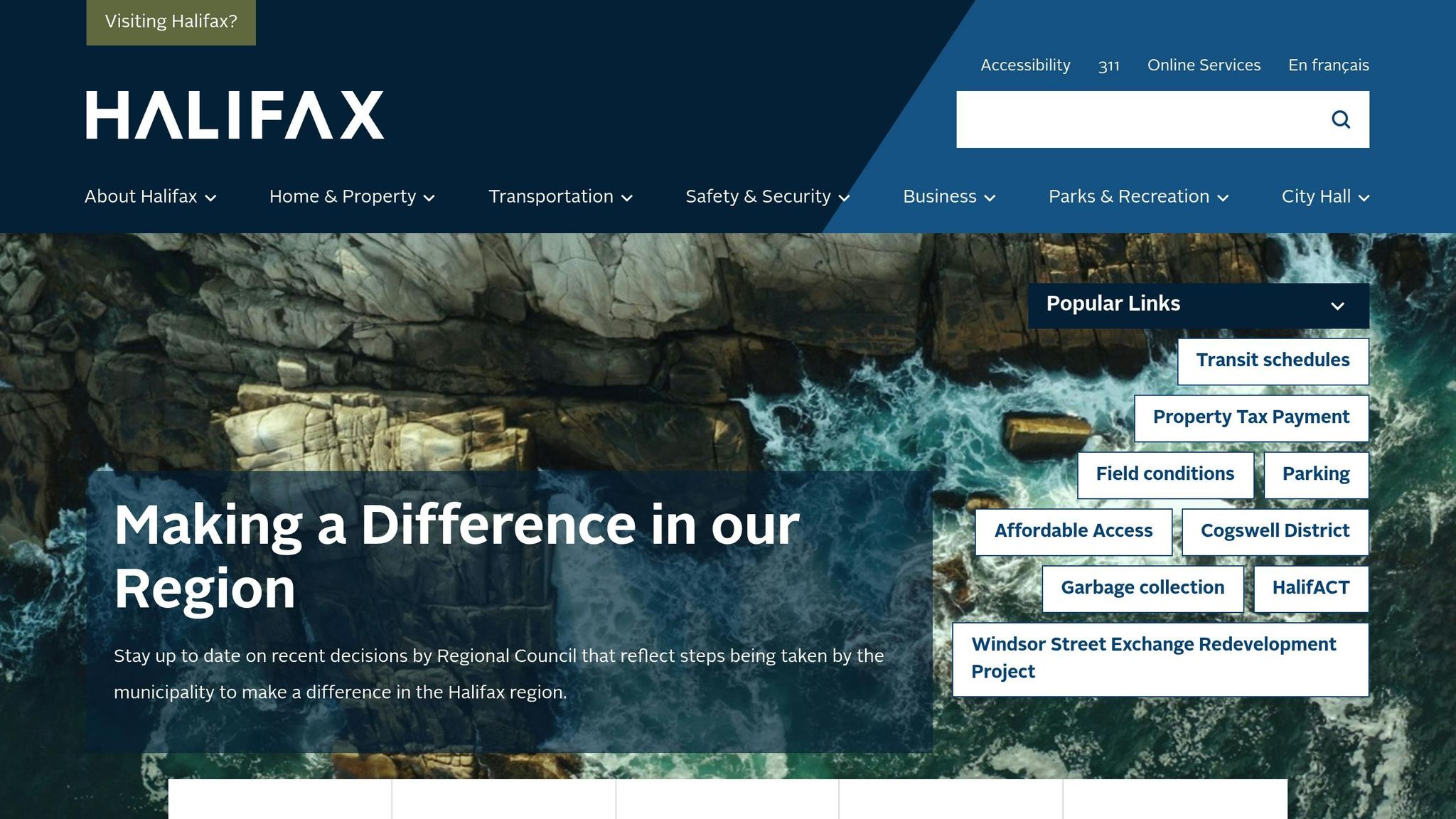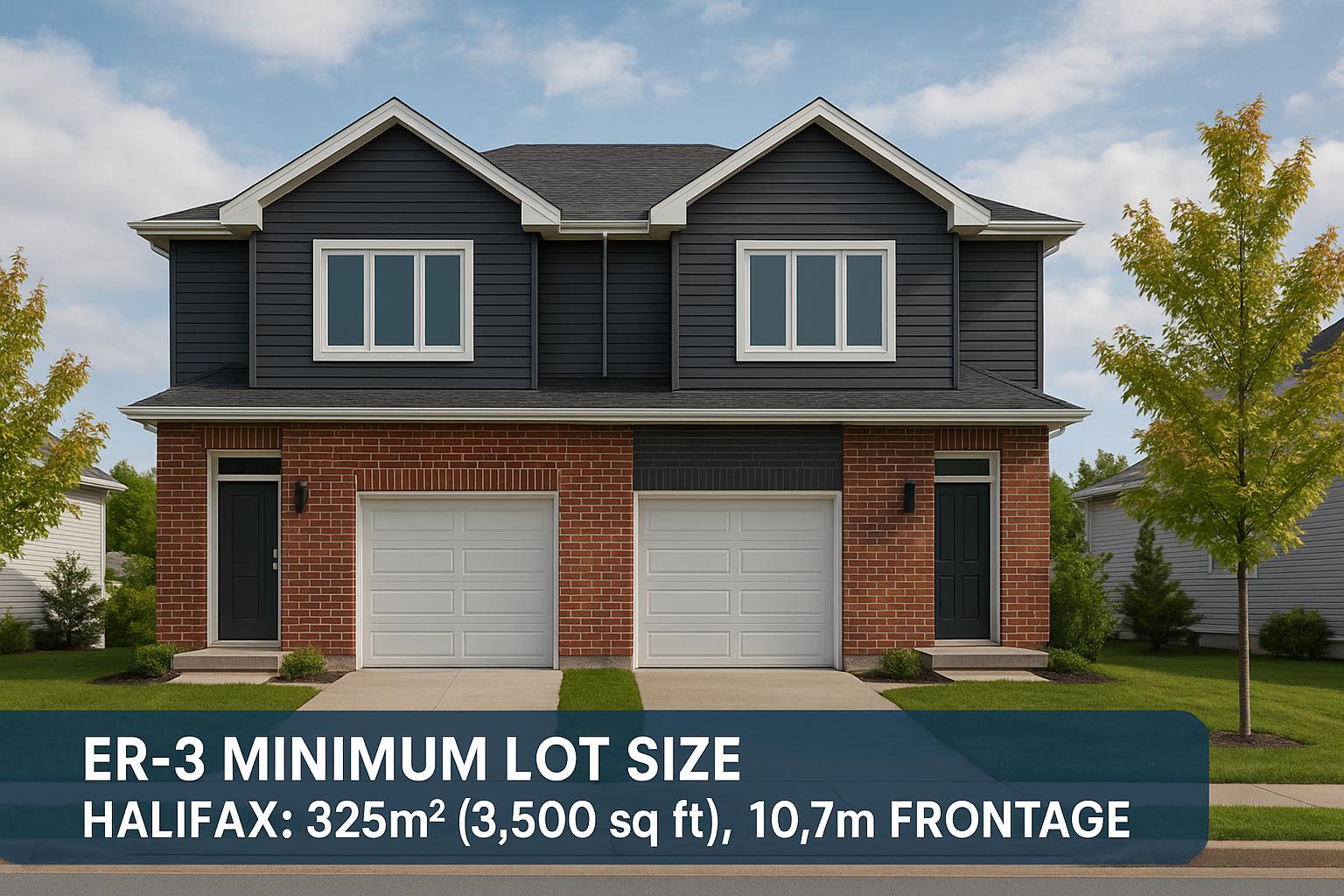Navigating development agreements in Halifax Regional Municipality (HRM) can be complex, especially for small projects that unexpectedly face the same regulations as large-scale developments. Here's what you need to know:
- What is a Development Agreement? A contract between property owners and HRM used when a project doesn't fit standard zoning rules.
- Why Small Projects Face Big Rules: Factors like zoning, density, height restrictions, or sensitive locations can trigger detailed reviews, even for smaller developments.
- Key Triggers: Exceeding density limits, height restrictions, parking ratios, or being in heritage or flood-prone areas.
- Approval Process: Includes pre-application consultations, public feedback, council approval, and final registration. This can take months and involves detailed documentation.
- Challenges: High costs, compliance with multiple studies (e.g., traffic or environmental), and delays due to fragmented coordination between professionals.
- Solution: An integrated design-build approach simplifies compliance by aligning all project aspects under one team, offering fixed costs and predictable timelines.
For property owners, preparing a thorough application and choosing the right construction partner is critical to avoid delays and unexpected expenses.
Public Consultation for PLANAPP-2023-00453 (Case 24650) 42 Canal Street, Dartmouth
What Triggers Big-Project Rules in HRM

Understanding what sets off big-project rules in Halifax Regional Municipality (HRM) is crucial for avoiding delays and ensuring projects remain compliant and cost-efficient. These triggers aren’t just about the size of a project - they also depend on site-specific characteristics and the evolving policies of local government.
Key Triggers and Thresholds
Several factors can require a project to go through the development agreement process, including:
- Certain municipal zoning classifications that mandate agreements, even for smaller multi-unit developments.
- Exceeding residential density limits, which can prompt a full review.
- Projects that surpass height restrictions must adhere to the development agreement process.
- Parking ratios that don’t meet regulations may require a variance through this process.
- Violations of local lot coverage or setback limits automatically trigger a full development agreement.
These triggers have led to updates in HRM’s policies to address emerging challenges.
Recent Policy Changes in HRM
Both provincial and municipal governments have recently updated their policies affecting development agreements. New planning guidelines and legislative amendments now outline specific criteria and exemptions. For example, some lots now allow limited construction without a full review. However, detailed assessments are still required for projects in areas like heritage zones, flood-prone regions, or environmentally sensitive locations.
These changes highlight the importance of a structured approach to development agreements.
Examples of Small Projects Affected
Even small-scale developments can be impacted by these rules. For instance, projects located on heritage properties, near waterfronts, along transit corridors, or in areas with geotechnical challenges often require full development agreements. These examples show that in HRM, it’s not just the size of a project that matters - factors like location and site-specific conditions play a significant role in determining the level of municipal scrutiny needed to ensure compliance.
How to Navigate the Development Agreement Process
Dealing with Halifax Regional Municipality's (HRM) regulatory framework can feel overwhelming, but breaking it down into clear steps makes the development agreement process more manageable. Here's what you need to know about the steps, timelines, and challenges involved.
Step-by-Step Approval Process
Getting a development agreement approved in HRM can take several months - or longer - depending on the complexity of the project and the level of community involvement. The process begins with a pre-application consultation with HRM planning staff. This step is crucial for identifying potential issues early on. Once you're ready to submit your application, you'll need to include detailed documentation, such as site plans, architectural drawings, engineering reports, and various supporting studies, along with the required fees.
After submission, the municipality reviews your application to ensure all necessary information has been provided. If anything is missing, the timeline may stretch further. The public consultation phase follows, which includes notification periods and often public meetings. These meetings allow community members to provide feedback, which may lead to design changes or additional requirements. Finally, the application is brought before council meetings for approval.
Once approved, the final steps involve signing the development agreement, posting securities based on a percentage of the construction value, and registering the agreement on the property title. Only after these steps are complete can you apply for construction permits. Using an integrated design-build approach can help simplify this entire process - more on that in the next section.
Community and Environmental Impact Requirements
Development agreements in HRM often come with specific assessment requirements that can impact both your timeline and budget. For example, traffic impact studies conducted by certified professionals may be needed if your project will affect local traffic patterns. Similarly, environmental assessments are required for projects near sensitive areas like watercourses or wetlands. These assessments can involve multiple phases, adding time and expense to your project.
In areas prone to flooding, you may need to prepare stormwater management plans and flood risk assessments. If your property is located in or near a heritage conservation district, a heritage impact assessment by a qualified expert will also be required. These additional studies and requirements can add layers of complexity and cost, which property owners must carefully plan for.
Common Compliance Challenges
Navigating the development agreement process isn’t without its hurdles. A common issue is the lack of coordination between planners, architects, engineers, and environmental consultants. When these professionals work independently, their recommendations can conflict, leading to delays and miscommunication.
Another challenge is the financial impact. Unexpected study requirements, design changes resulting from public consultations, and rising fees due to drawn-out timelines can push budgets beyond their limits. However, the most significant challenge is often timeline uncertainty. Delays can disrupt construction schedules and complicate financing, especially when no single entity is accountable for the process.
One way to tackle these challenges is by adopting an integrated design-build approach. This method brings all the necessary professionals together under one team, ensuring streamlined communication, predictable timelines, fixed costs, and a smoother path to project completion.
sbb-itb-16b8a48
Integrated Design-Build Solutions for Simplified Compliance
In Halifax Regional Municipality (HRM), the traditional construction process often leaves property owners juggling multiple teams - planners, architects, engineers, and environmental consultants - all working independently. This fragmented system can make it especially difficult to meet development agreement requirements, which demand close collaboration across these disciplines.
The integrated design-build approach offers a streamlined alternative. By consolidating all aspects of a project under one team, property owners avoid the headaches of managing multiple contracts. From the initial planning stages to final construction, a single team ensures seamless coordination, addressing both compliance and cost concerns effectively.
Here’s a closer look at how integrated design-build simplifies the process compared to traditional methods:
Fragmented vs Integrated Construction Approaches
When considering HRM's regulatory environment and the need for efficient project delivery, the contrast between traditional construction and integrated design-build becomes clear:
| Aspect | Fragmented Construction | Integrated Design-Build |
|---|---|---|
| Accountability | Multiple contracts, often leading to finger-pointing | One team takes full responsibility for the project |
| Cost Control | Budget overruns of 30–60% due to poor coordination | Fixed-price contracts keep costs predictable |
| Timeline Management | Projects can stretch from 8 to 18+ months | Six-month construction timeline is guaranteed |
| Regulatory Compliance | Conflicting advice from independent consultants | Unified compliance strategy from the start |
| Communication | Owners manage relationships with multiple teams | One team handles all internal coordination |
The inefficiencies of fragmented construction can cost property owners an average of $47,000 in additional coordination expenses. Integrated design-build eliminates this by aligning all disciplines from the outset, saving both time and money.
Helio Urban Development, the only integrated design-build company in Nova Scotia specializing in 4+ unit rental properties, exemplifies this approach. With a portfolio of 31 completed units, Helio ensures full accountability throughout every stage of the regulatory compliance process by bringing all experts under one roof.
Benefits of Fixed-Price and Guaranteed Timelines
Cost and timeline management are critical concerns for property owners, and traditional methods often leave room for financial uncertainty. Fixed-price contracts, a hallmark of integrated design-build, lock in costs before construction begins. For example, in HRM, the cost of building a standard fourplex is set at $160,000 per unit, totalling approximately $640,000 for the project - no surprises, no hidden fees.
The assurance doesn’t stop there. A fixed six-month timeline means property owners can reliably plan for rental income - typically around $8,000 per month for a standard fourplex. To further solidify this commitment, many integrated builders include financial penalties (up to $1,000 per day) for delays beyond the agreed timeline.
Advanced scheduling tools play a key role in maintaining these guarantees. By aligning construction activities with regulatory milestones, permits are secured in sync with the project’s progress. Plus, features like daily photo updates and real-time project portals keep property owners informed and allow for quick resolution of any issues that arise.
With fixed pricing, guaranteed timelines, and a fully integrated approach to compliance, HRM property owners can navigate the development process with confidence and efficiency.
Practical Advice for Property Owners
Navigating Halifax Regional Municipality's (HRM) development agreement process can feel overwhelming, but taking practical steps can make it more manageable. A well-prepared application and the right construction partner are key to ensuring your project moves forward smoothly.
Preparing a Compliant Development Agreement Application
When submitting a development agreement application, include all the necessary details about your proposed project, such as the number of units and other specifics. Working with experienced professionals can make this process much easier and help avoid common pitfalls. A clear and well-organized application not only speeds up the review process but also reduces the chances of delays. Make sure every detail is documented and double-checked for compliance before submission. Once your application is ready, shift your focus to finding a construction partner who can bring your plans to life.
Identifying and Addressing Regulatory Triggers
Understanding what might trigger additional regulatory requirements is crucial for effective planning. Start by reviewing your property’s zoning classification, density limits, height restrictions, and parking requirements. Properties located in heritage zones, flood-prone areas, or environmentally sensitive regions often face stricter regulations. Conducting a thorough site assessment early on can help uncover potential compliance issues. By addressing these hurdles before submitting your application, you can avoid unnecessary delays in the approval process.
Choosing the Right Construction Partner
The construction partner you choose can make or break your project. Look for a partner with a solid track record in handling HRM development agreements. Instead of revisiting the benefits of integrated design-build solutions, focus on what matters most: their qualifications. Check their references, confirm they have proper insurance and bonding, and assess their financial stability. A reliable construction partner can help you navigate HRM’s regulatory challenges, keeping your project on track and within budget.
Conclusion: Simplifying Development in HRM
Navigating Halifax Regional Municipality's (HRM) development agreement requirements can feel daunting for property owners, but it’s entirely manageable with the right approach. The key takeaway? Even smaller multi-unit projects can fall under the same stringent rules as larger developments, so preparation is essential from the outset.
Success starts with understanding the regulatory triggers, following a structured process, and opting for a streamlined construction approach. Properties with specific zoning, density, or other conditions may face additional hurdles, but identifying these early can save you from costly surprises later.
Fragmented methods often lead to delays and unexpected costs, especially in HRM's intricate regulatory maze. Missing key deadlines could mean months of postponed rental income or occupancy permits - a risk no property owner wants to take.
Integrated design-build solutions provide a practical way forward. With fixed-price contracts - set at $160,000 per unit - and six-month timelines, these solutions offer property owners much-needed cost certainty and predictable schedules. They also handle permitting and site coordination, leveraging local expertise to navigate municipal offices in Halifax, Dartmouth, Bedford, and the surrounding areas [1].
This cohesive approach doesn’t just simplify the approval process; it also has a direct financial impact. For example, a fourplex generating $8,800 in monthly rental income benefits significantly from a faster, more reliable construction timeline.
While HRM’s regulatory environment will undoubtedly continue to evolve, property owners who understand the triggers, submit thorough applications, and collaborate with experienced construction teams can successfully meet these requirements. The ultimate goal? Not just compliance, but building rental properties that are both profitable and fully aligned with municipal standards.
FAQs
What steps can property owners take to navigate the development agreement process in HRM and avoid unexpected delays or costs?
To successfully navigate the development agreement process in Halifax Regional Municipality (HRM), property owners need to start by understanding the zoning rules and thresholds that apply to their project. Even relatively small multi-unit rental developments can sometimes fall under regulations designed for larger projects, so reviewing these details early is essential.
Connecting with municipal planning staff and professionals who are well-versed in HRM’s regulations can provide clarity on key requirements, like community impact assessments and municipal approvals. Taking the time to prepare detailed and accurate documentation, while addressing potential concerns upfront, can help avoid unnecessary delays or costly revisions. Staying organized and informed throughout the process ensures projects stay on track and align with local regulations.
What are the advantages of using an integrated design-build approach for small multi-unit projects in HRM?
An integrated design-build approach brings several advantages for small multi-unit projects in Halifax Regional Municipality (HRM). By consolidating design and construction into a single contract, this method provides one point of accountability, minimizing confusion and reducing the chances of miscommunication between separate teams. This streamlined approach helps property owners sidestep common issues like delays, unexpected expenses, and coordination challenges often seen in traditional construction methods.
Another key benefit of the design-build model is its potential to deliver faster project timelines and more precise cost estimates. Since the builder and designer collaborate from the outset, the process becomes more cohesive and efficient. This is especially useful in HRM, where navigating zoning rules, municipal approvals, and community impact considerations can be challenging. With a unified team, the process is not only smoother but also more predictable, keeping your project on schedule and within budget.
How do recent changes in HRM's policies affect development agreements for smaller projects, particularly in heritage or flood-prone areas?
The Halifax Regional Municipality (HRM) is navigating a transitional phase as its proposed updates to the Regional Plan remain under review by the Province of Nova Scotia. With these amendments not yet approved, the 2014 Regional Plan, last updated in May 2025, continues to guide development in the region. This means that any smaller projects, particularly those in sensitive areas like heritage zones or regions prone to flooding, must adhere to the regulations laid out in the 2014 plan.
HRM is working closely with the province to bring the Regional Plan in line with current provincial legislation. While these revisions are underway, property owners need to pay close attention to the existing requirements. Staying informed and compliant with the current rules is essential to avoid delays or complications with projects.



